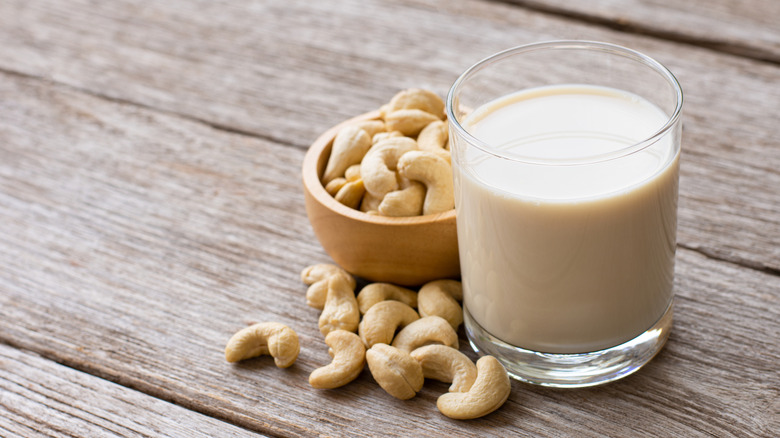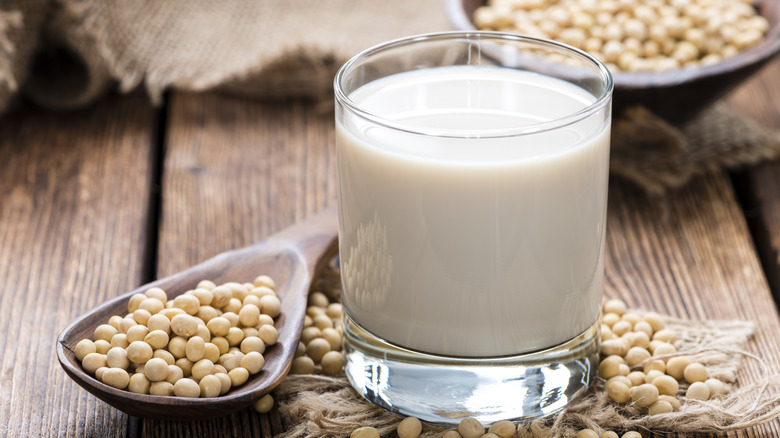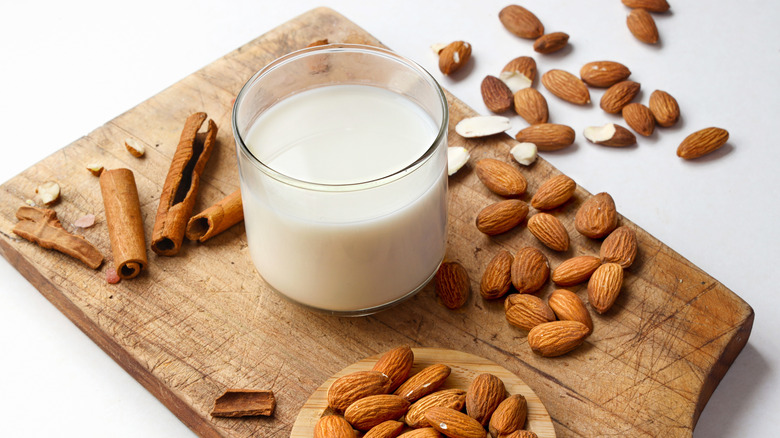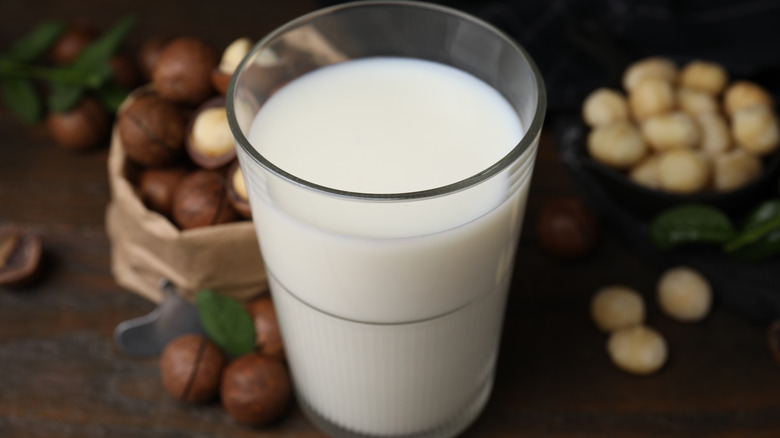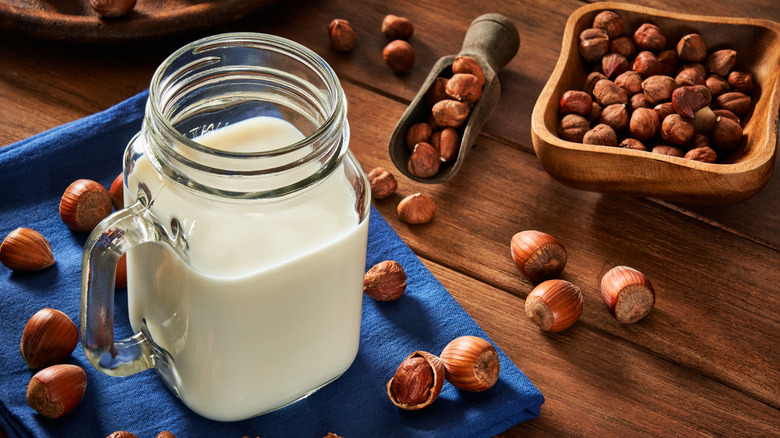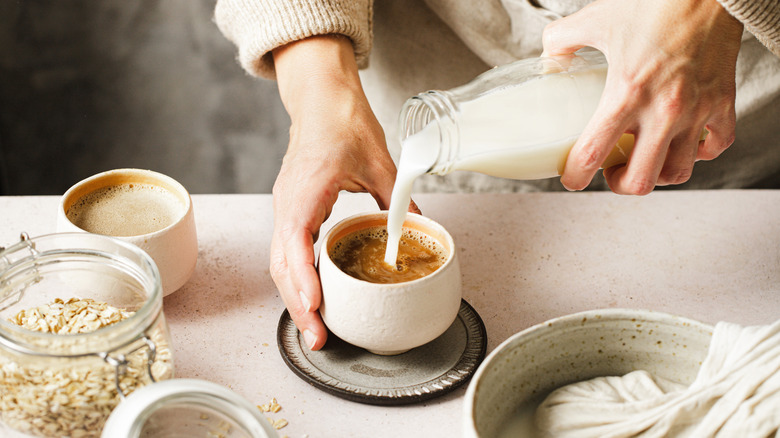5 Best And 5 Worst Plant-Based Milks For Coffee
We may receive a commission on purchases made from links.
While the demand for plant-based milks has dropped slightly in the past year (largely due to consumers' economic concerns), it still remains high. Folks looking to lessen their environmental impact, support their personal health, or simply try something new are able to scan grocery store shelves and find an ever-increasing variety of plant-based milks at their disposal. With so many choices, however, it can be difficult to decide which plant-based milk is right for you, especially because the product that makes your cereal sing is not necessarily the same one that will complement your baked goods.
Coffee is where you'll observe some of the most noticeable differences among plant-based milks. Some types tend to steam and froth extremely well, while others yield only a few lonely bubbles. Several plant-based milks possess neutral flavors that complement, and even enhance, the tasting notes of coffee, while others are obtrusive in flavor. To help reduce the amount of trial and error you must undergo, I've compiled this list of the five best and five worst plant-based milks for coffee.
As a plant-based lover of teas and coffees, I've had my fair share of experience with many types and brands of milk alternatives. To supplement my observations, I've also consulted two coffee experts: Ian Butera is the coffee director at Camino Bakery in Winston-Salem, North Carolina, and Kayla Taylor has worked as a barista at First Slice Pie Café and A Taste of Heaven in Chicago. Together, we discussed each plant-based milk's flavor, viscosity, tendency to curdle, frothing and steaming capability, and ideal uses. More notes on methodology can be found at the end of this guide.
Best: Oat Milk
After taking into consideration our various experiences with adding plant-based milks to coffee, oat milk won hands-down. Each of us believes that it deserves the hype it has received over the past few years for its versatility, creaminess, and sweet, yet subtle flavor. Ian Butera told me that "oat milk is by far the most popular of the alternative milks" at Camino Bakery, as well as his personal favorite. He further noted that, "it adds flavor that is most similar to small vat pasteurized milk, which is what we use in our shops."
Butera said that while, "There are differing opinions on whether oat milk steams the best," he still prefers it in his own steamed milk beverages. His favorite is "an oat milk cortado with a brighter single origin coffee." When it comes to frothing oat milk, Kayla Taylor gave the beverage high marks. Using a barista blend such as Oatly Barista Oat Milk can lend a higher fat content, which Taylor said helps "hold the foam together." Even after taking barista blends out of the picture, however, Butera said that oat milk is one of the more viscous plant-based milks. This thickness is what gives it a more similar mouthfeel to cow's milk.
Taylor noted that she sees oat milk curdle less often as compared to almond and soy milk. She added that this may also depend on the brand, so don't forget to learn about the best oat milk to choose for rich and foamy espresso drinks before heading to the grocery store.
Worst: Cashew Milk
Cashew milk can be a hit or miss in coffee. Some brands are thin while others are creamy, so you'll be taking your chances when buying a cashew milk-based beverage from a coffee shop. Besides, cashews aren't exactly cheap, so you won't find it being offered very frequently. One of the most reliable forms of cashew milk is also one of the most labor intensive: Homemade cashew milk recipes can be adjusted as per your preferences. However, Ian Butera told me that, "Unfortunately, because of the economics of scale, it is almost always cheaper to buy commercially manufactured alternative milks than produce them at home." In any case, there are a few reasons why your homemade cashew milk might turn out grainy, so you should be prepared for some trial and error.
Cashew milk is not an outstanding choice when it comes to frothing, though I would not consider it the worst either. It is also on the sweeter side, so stay away if you are looking for more neutral flavors from your plant-based milk. Finally, cashew milk does have a tendency to curdle. For context, Butera reported that, "the primary mechanism for milk curdling in coffee is a combination of heat and acidity breaking the milk proteins. Oftentimes, you need both an acidic coffee and a very high temperature coffee (over 200 degrees Fahrenheit) to cause those proteins to lose their cohesiveness." So, if you choose to use cashew milk, shake the container well, then gently heat it before mixing it into your coffee. This should help reduce curdling.
Best: Pea Milk
One of my favorite plant-based milks to add to coffee or tea is a variety that has flown somewhat under the radar: pea milk. Specifically, I like to use Ripple Pea Milk. It is based in water and pea protein, fortified with nutrients like DHA and calcium, and thickened using a handful of ingredients like organic guar gum and gum acacia. Its flavor is subtly sweet, while also being a world away from the green peas you eat for lunch and dinner. The texture of this pea milk is also outstanding; when added to coffee, it results in a rich, creamy cup of joe. That's because pea milk is made from protein-packed yellow split peas, allowing it to mimic cow's milk surprisingly well, especially when it comes to frothing. I can gratefully report that I don't have many issues with it separating when added to coffee or tea, either.
In my opinion, legume-based milk is an untapped market. Legumes in general — not just peas — are favored for their ability to thicken and bind everything from veggie burgers to mousse. These properties can, and should, transfer over to the realm of coffee, and indeed, some of my favorite hot beverages have been crafted with lentil-based milk. Additionally, some popular plant-based creamers, such as those made by Planet Oat, already include pea protein on their ingredient lists.
Worst: Soy Milk
I can't attest to what Train's band members were thinking when they wrote the hit song "Drops of Jupiter," but "the best soy latte that you ever had" may not actually have been that great. Though this milk does get kudos from those with nut allergies (and is therefore a favorite of Kayla Taylor, who has nut allergies herself), Ian Butera and I both ranked soy milk as one of the worst plant-based milks for coffee. Right off the bat, it can have a strong flavor that masks the complex notes of coffee. Butera explained that, "Soy milk is widely regarded as the most abrasive in flavor and hardest to work with." In particular, he noted that soy milk is "truly awful to work with when steaming," meaning you won't be able to achieve that coveted microfoam every time.
On the other hand, Taylor reported that she enjoys the creamy texture of soy milk, finds it sweet, and has had success in frothing it. One of the longest-used plant-based milk alternatives, there are many brands of soy milk on the market, each of which will act differently in your cup of joe. For example, while I cannot stand any other form of soy milk, I will concede that Silk's chocolate soy milk makes for a great mocha — and I have friends who agree. The question of how well suited soy milk is to coffee may be just as divisive as whether or not cilantro tastes like soap, so by all means, experiment for yourself and let us know what you think.
Best: Almond Milk
These days, you'll find almond milk at just about any coffee shop, likely alongside oat, soy, and regular cow's milk. Not quite as viscous as oat milk, Ian Butera told me that almond milk still "steams well and creates good microfoam." He said this is the case even if you are not using a barista blend. However, Butera noted that almond milk can have "a dry, paper-like taste" and "is better used in iced coffee beverages or just drip." Taylor also agreed that almond milk is better suited for iced drinks. I enjoy almond milk in an iced latte with basil syrup, as well as any time where I'm in the mood for a lighter beverage.
Of course, variations in taste may largely depend on the brand of almond milk you use. If you prefer using homemade almond milk, that's certainly an option as well: Butera reported that "homemade versions [of plant-based milks] do maintain the thicker body that commercial versions have and are less sweet." Even so, the ratio to follow for homemade almond milk is easily adaptable and highly personal. Because almond milk recipes typically do not include emulsifiers, you may encounter a greater tendency for your homemade almond milk to separate when added to coffee. Warming it (but not boiling it) can help reduce this risk.
Worst: Hemp Milk
Out of all the plant-based milks, hemp milk imparts one of the strangest flavors to coffee, and it won't go unnoticed by most folks. While you may initially be enticed by its protein content, as well as its omega-3 and omega-6 fatty acids, you'll quickly be disappointed by its nutty, earthy, and even grassy flavor. Not only do I avoid using hemp milk in coffee, but I try to avoid using it in general.
Besides its flavor, hemp milk tends to be thin, so it's certainly not your best choice for hot coffee beverages that rely on a creamy mouthfeel. Despite this, you may experience variable success in frothing hemp milk because of its generous amount of protein. I have had good results with the Pacific Foods brand of hemp milk, but I don't often find it (or any other brands of hemp milk) stocked at the grocery store.
Kayla Taylor told me that while she does not like hemp milk, it "may be good in drinks where its flavor is an element of the drink and is balanced out by something else." For instance, a maple tahini latte, peanut butter latte, or pandan coffee may play nicely with hemp milk.
Best: Macadamia Milk
Macadamia milk may be slightly expensive and not very common in coffee shops, but that doesn't mean you shouldn't enjoy it from time to time at home. In fact, with its high protein and fat content, it is the underrated non-dairy milk you should be frothing for homemade lattes. The protein in macadamia milk helps create bubbles, while its fat helps stabilize and preserve those bubbles so that they don't disappear after just one or two sips. In this regard, some folks consider it better than almond milk, which can sometimes be too thin. Milkadamia is one of the most common macadamia milk brands and the one I have most frequently used in my own beverages at home. The brand offers both sweetened and unsweetened versions of its barista blend, which are equally wonderful in matcha lattes.
If you love complex, nutty flavors, then you'll also find that macadamia milk tastes heavenly in both hot and cold coffees. I recommend pairing macadamia milk with coffee varieties that do not already carry nutty undertones. Similarly, you might not want to use it for making an Almond Joy latte. Instead, make the most of its distinctive flavors by using it in conjunction with coconut milk, incorporating it into a café con miel, or preparing a rich and creamy mocha.
Worst: Hazelnut Milk
Hazelnut milk can be expensive, which is one of the primary reasons why you won't find it offered in many coffee shops. It also tends to curdle in hot, acidic beverages like tea and coffee. The most significant reason I don't recommend adding hazelnut milk to coffee, however, is its flavor.
Hazelnut coffee is nice on occasion, but unless you're ready to taste it every morning, it's best to leave that carton of hazelnut milk on the grocery store shelf. Its noticeably nutty flavor can mask the tasting notes of even a strongly brewed cup of coffee, and you may miss out on noticing coffee beans' fruity, floral, or smoky elements. It's better to keep a vial of hazelnut extract or hazelnut syrup on hand for when the craving strikes rather than tire of the delicious European specialty because of using the wrong plant-based milk.
All that said, if you have a carton of hazelnut milk on hand, try using it in a mocha or dessert coffee. You may also want to use it alongside coffee beans that you have not bought specifically for their flavor, since you may not be able to taste it anyway.
Best: Coconut Milk
From cinnamon-infused coconut lattes that can be enjoyed year-round to pandan lattes that will astound you with their vibrant green color, coconut milk's sweet flavor is certainly a game changer in the world of coffee. On cold days, I love cozying up with a hot latte made using rich coconut milk, maple syrup, and a pinch of pumpkin spice. Alternatively, coconut milk pairs impressively with iced drinks, such as iced mochas that approach Bounty bar territory. If you find it difficult to achieve a creamy foam with coconut milk, you're not alone. That's why Kayla Taylor agrees that coconut milk might be better suited to iced drinks.
When adding coconut milk to coffee, you can use either canned coconut milk, which is thick, or carton coconut milk, which is thin. The latter is typically preferred when pouring large quantities, unless you've got a particularly strong appetite and don't mind a robust coconut flavor. If you have a can of reduced fat coconut milk on hand, that is also a viable option. That said, while canned coconut milk is not typically stocked in coffee shops, it does have its time and place. For instance, you can freeze canned coconut milk to boost the texture of iced coffee. Additionally, a can of coconut-based condensed milk may be just what you need when preparing Vietnamese coffee.
Worst: Rice Milk
Rice milk is not commonly offered in coffee shops for a reason, and you should consider a few factors before adding rice milk to your coffee. First and foremost, this plant-based milk loses out to other alternative milks due to its thin nature. Rice milk's low protein and fat content means that it cannot be steamed or frothed, and it also lends a subpar viscosity when added to practically any style of milk-based coffee.
Despite its pitfalls, according to Ian Butera, "rice milk has the least impact on the overall flavor of a cup of coffee." Indeed, many folks enjoy its subtle sweetness, especially when combined with complementary flavors like vanilla and even banana (in case you've never tried it, banana-infused milk is incredible in coffee). If you're dead set on trying rice milk, Kayla Taylor recommends using it in iced beverages. I agree; one place where I would prefer rice milk is in an iced horchata latte, where this plant-based milk is actually key to preserving the drink's thematic integrity.
Otherwise, if you absolutely must use rice milk in a hot beverage, I would suggest combining it with another alternative milk, such as oat milk. This will help you reap the rewards of its sweet flavor and tendency not to curdle, while still adding some much-needed creaminess to your coffee. However, if you like a lighter beverage, you may get away with using rice milk alone.
Methodology
In compiling this list, I largely drew upon my personal experiences as a vegan chef of adding plant-based milks to coffee in kitchens with minimal equipment. I also learned from the expertise of two coffee professionals: Ian Butera and Kayla Taylor. I selected plant-based milks that were commercially available to make the suggestions listed here more relevant to those with limited time and resources. While the relative affordability of a plant-based milk was sometimes given, this was not a primary factor in determining whether a particular variety ranked among the "best" or the "worst" alternatives. Instead, I focused on the taste of each plant-based milk, its viscosity, and how conducive it is to steaming and frothing.


